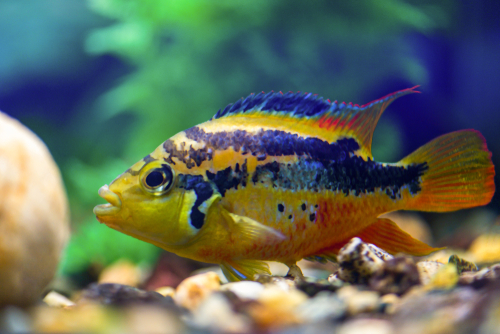There are many different things to consider when you’re researching new and exciting fish that could make a great addition to an aquarium, but perhaps the first thing that we notice is the stunning colors and patterns on display.
Bright yellow stripes are not too common in the animal kingdom, so they certainly catch the eye when you do see them. If you want to add some vibrancy to your tank – or you just want to discover more about the kinds of fish that exhibit this unique marking – then you’ve come to the right place.
In this article, we are going to investigate a few of the most popular fish with yellow stripes that are loved by hobbyists all over the world. They vary greatly in size, shape, and even pattern and color, but they all have a bright and beautiful thing in common.
Contents
Fish With Yellow Stripes
More similar posts:
- Popular Fish That Look Like Sharks
- Popular Fish With Black Stripes
- Popular Fish That Look Like Snakes
- Popular Fish That Look Like a Stingray
1. Regal Angelfish
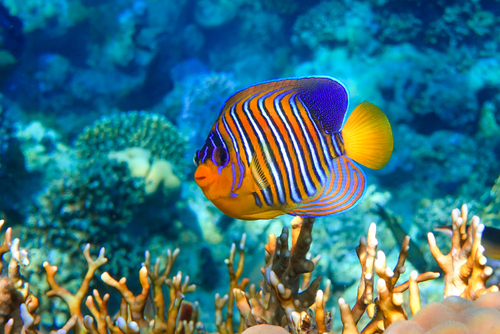
- Scientific name: Pygoplites diacanthus
- Diet: Omnivore
In the world of fish, you won’t find many that are more stunning and iconic than the angelfish, and the Regal Angelfish is perhaps the most captivating of them all. They are covered in neat yellow, black, and white stripes, and their entire bodies are framed in a vivid and vibrant blue.
These are not the easiest fish to care for, but they are usually peaceful and non-aggressive as long as they are not around other angelfish. It can take some time for a Regal Angelfish to get used to a new environment, and they are vulnerable to disease and parasites, so it is important to introduce them carefully.
2. Copperband Butterflyfish
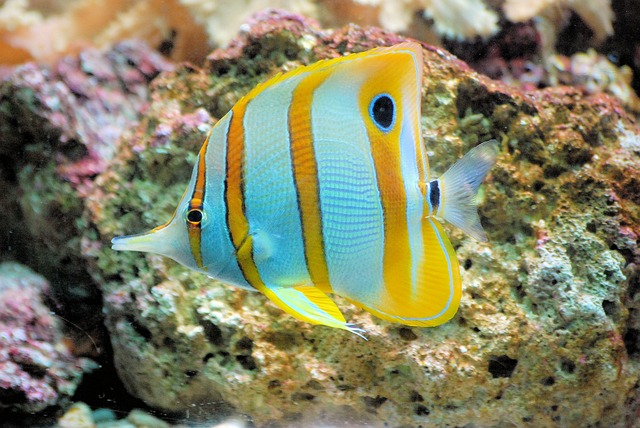
- Scientific name: Chelmon rostratus
- Diet: Carnivore
The Copperband Butterflyfish is a very elegant and distinctive creature. It has a beautiful triangular body, a long, narrow snout, and bright yellow vertical bands. Each individual stripe on their little white bodies is framed with black lines, making them even more characteristic and memorable.
They are best suited to large reef tanks and are quite particular in their needs. They can easily become stressed around other fish and they are even a bit shy when it comes to feeding, so it can be a challenge to make sure they are comfortable and well-nourished.
3. Green Terror Cichlid
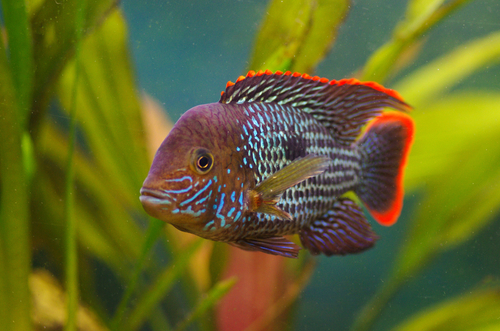
- Scientific name: Andinoacara rivulatus
- Diet: Omnivore
There are few fish species that are more exciting to look at than the Green Terror Cichlid. They have silvery, iridescent blue/green bodies covered in little spots, and the males have an iconic yellow/orange stripe that runs along the top of their dorsal fins and frames the end of their tails.
They are not too challenging to care for, but they do require quite a lot of room to move around in. Green Terror Cichlids like to roam, so a 75-gallon tank is usually the minimum a pair would need to be happy.
Otherwise, they are quite hardy and are not as particular as some species when it comes to their water conditions.
4. Clown Tang
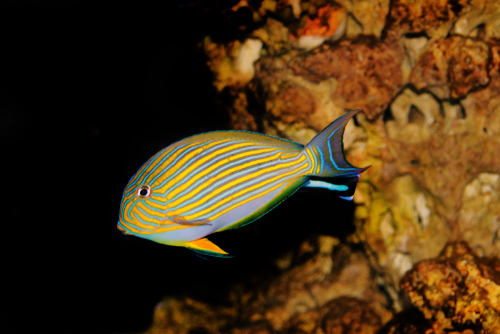
- Scientific name: Acanthurus lineatus
- Diet: Omnivore
Clown Tangs are cute and expressive fish that add a lot of color to your tank. These saltwater beauties are covered in vivid yellow, blue, and white stripes that make them instantly recognizable.
They are one of the larger surgeonfish and, though they might look long and skinny most of the time, they can stretch their fins out to make themselves much taller.
These fish are very active swimmers, and they like to be in a healthy reef environment with plenty of space to move around. They generally require quite a sizeable tank, and they need lots of places to hide and material to forage if they are going to stay happy and healthy.
5. Black Banded Leporinus

- Scientific name: Leporinus fasciatus
- Diet: Omnivore
The yellow and black stripes on these fish are very strong indeed, and they are one of the main reasons why the Black Banded Leporinus is such a popular species. They have long bodies and their markings almost make them look like underwater bumblebees.
They actually gain more stripes as they get older, because the black bands on their sides split into two every year or so, which means that you can count them to tell how old they are.
The Black Banded Leporinus is relatively friendly and can usually be kept with other tankmates, though they do tend to fight amongst themselves and are known to nip at more aggressive fish that they encounter.
6. Fancy Yellow Guppy
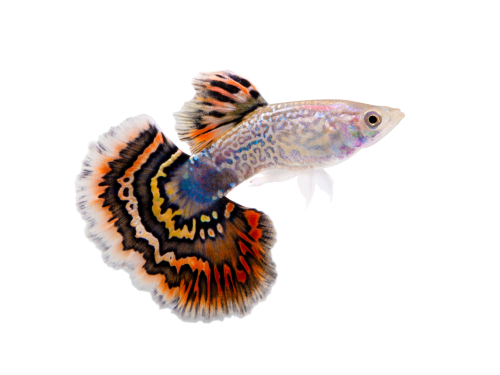
- Scientific name: Poecilia reticulata
- Diet: Omnivore
The humble Guppy is one of the most famous and widely-loved fish in the entire aquarium world. One of the reasons why they are such wonderful fish to raise and care for is the exciting and beautiful variety of patterns and colors that they come in.
Fancy Yellow Guppies can have incredibly vibrant and distinctive yellow stripes, though their exact appearance will vary depending on their breeding.
They are very easy to look after and one of the easiest fish species to breed yourself, so you may find that you end up with more Guppies than you expected.
7. Jaguar Cichlid
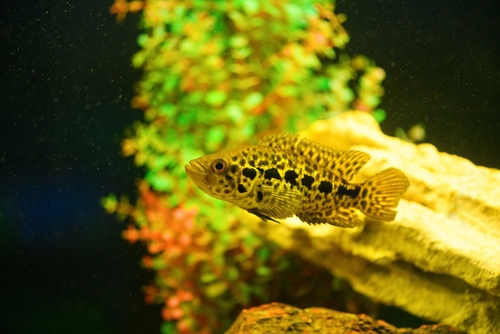
- Scientific name: Parachromis managuensis
- Diet: Omnivore
These large freshwater cichlids are popular and feisty creatures that are highly sought after for their mottled, jaguar-like markings.
Although not every Jaguar Cichlid species does have noticeable “stripes” (and some are less yellow than others), many will have very distinctive yellow bands down their sides, blending in with the captivating patterns that give them their name.
These fish are usually recommended for hobbyists with a bit of experience, as they can be slightly aggressive, and may grow to more than 16 inches in length. They need a lot of space, a thick substrate, and lots of decorations to try and replicate the murky lakes, ponds, and rivers that they come from.
You do have to keep an eye on these fish, though, as they are known to dig up the plants in their tanks and throw things around.
8. Blue Danio
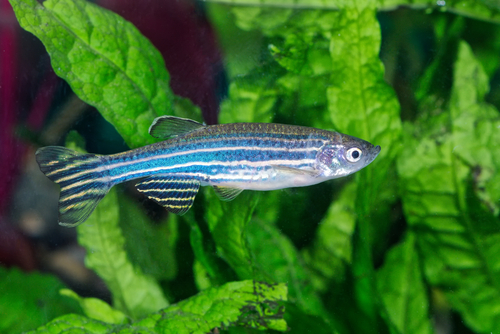
- Scientific name: Danio kerri
- Diet: Omnivore
There are a huge number of different Danios out there to choose from, and Blue Danios are one with an electric appearance. Down the side of their pale blue bodies, they typically have two bright yellow stripes that run from their eyes to their tails, almost like a bolt of lightning.
They are a pretty hardy species that can survive in a variety of different conditions, and they are usually quite sociable and peaceful with their tankmates. They do like to be in a social group, so it is best to have at least 8 individuals together.
9. Auratus Cichlid

- Scientific name: Melanochromis auratus
- Diet: Omnivore
Also known as the Malawi Golden Cichlid, the Auratus Cichlid is a very bright and beautiful little creature. These cichlids are known for their aggressive nature, which seems fitting considering how much their coloring looks like a classic “danger” sign – with yellow and black stripes running horizontally down their bodies.
They can be pretty unpleasant to other fish that they might be housed with, and they have some particular care needs that make them a bit of a challenge to an inexperienced hobbyist. They like quite specific water conditions and large tanks, and they are susceptible to disease.
10. Salvini Cichlid
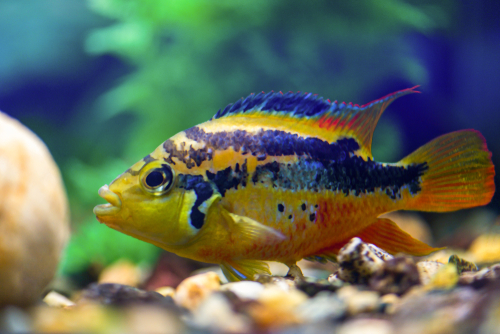
- Scientific name: Trichromis salvini
- Diet: Omnivore
There are not many cichlids that are more colorful and varied than the Salvini Cichlid. These wonderful creatures have elongated bodies marked by beautifully unique horizontal stripes. They can range in color from pale yellow to a darker orange, but they are always eye-catching and impressive.
They like to live in large community tanks, but they are known for being relatively aggressive. To make sure that they stay out of trouble, they need enough room to establish their own territory. Otherwise, they are not too picky when it comes to things like water parameters and substrate needs.
11. Clown Loach
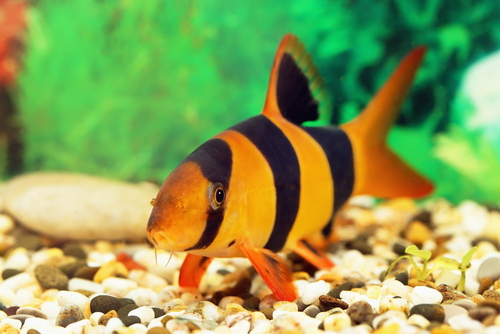
- Scientific name: Botia macracantha
- Diet: Carnivore
Clown Loaches are certainly some of the boldest yellow and black striped fish out there. They have strong yellowy-orange and black bands (typically three or four of each) that almost look like they have been designed by a cartoonist.
Some Clown Loaches have very yellow stripes, while others are considerably more orange in appearance. They all have long noses and lean bodies, with a distinct red tinge to the end of their tails.
These fish are a peaceful and pleasant addition to any aquarium as they tend to be friendly with almost any tankmates. They are also very active and fun to observe throughout the day.
12. Venustus Cichlid
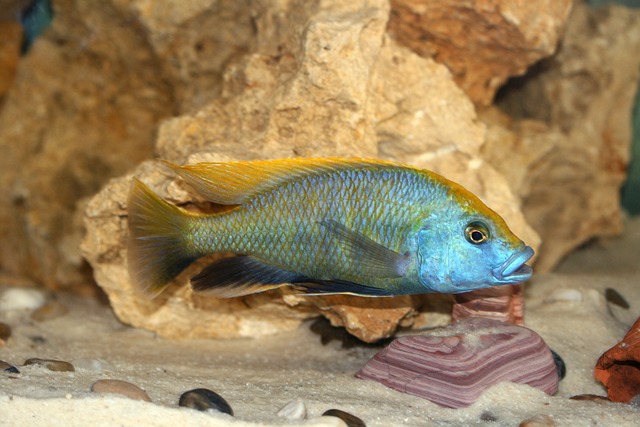
- Scientific name: Nimbochromis venustus
- Diet: Carnivores
These African cichlids are also known as Giraffe Haps, which tells you a little about the way that their yellow markings can look. Across their bodies, Venustus Cichlids have a pattern of crisscrossed yellow stripes that almost give the appearance of giraffe-like dark splotches in between.
They also have a strong, vibrant yellow stripe that runs all along the top of their upper fin.
Venustus Cichlids are an intelligent and interesting species that are known for submerging themselves completely in the sand when they hunt, which is a fascinating behavior to observe.
They are a little more challenging to look after than some fish, though, because they are semi-hardy and moderately aggressive.
13. Clown Killifish
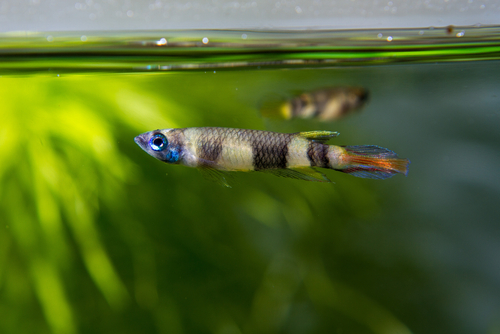
- Scientific name: Aplocheilus annulatus
- Diet: Carnivore
This little panchax is a very entertaining fish to care for, and they have a wonderfully distinctive look as well. Clown Killifish (also known as the Banded Panchax) have long bodies marked by yellow stripes, and they have wonderfully blue and orange tails as well.
They are a good option for beginner/intermediate hobbyists and they do not require a huge amount of space to be comfortable, but they do enjoy a slow current so you will need an effective filter to keep them happy.
Clown Killifish are generally quite relaxed and shy, but they will start to play with each other and jump when they are feeling comfortable.
14. Altum Angelfish
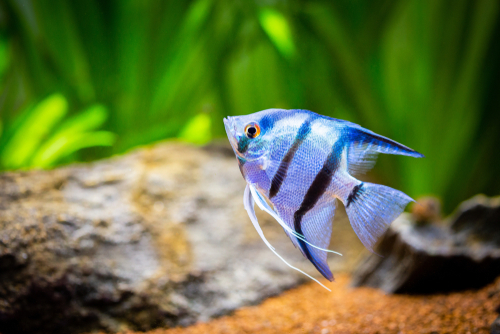
- Scientific name: Pterophyllum altum
- Diet: Omnivore
Though their yellow coloring is perhaps a little more muted than some of the other fish on this list, Altum Angelfish are truly beautiful and elegant specimens. They have incredibly high dorsal fins and long ventral and anal fins, which means that they need a tall tank in order to feel comfortable.
They have distinct black stripes, with yellow stripes in between that can vary in their vibrancy. They can be quite vulnerable to predators and are quite sensitive, which means they have particular needs when it comes to water quality and temperature and should only be housed alongside smaller species.
15. Gold Gourami

- Scientific name: Trichopodus trichopterus
- Diet: Omnivore
What list of popular aquarium fish would be complete without mentioning at least one gourami? There are 86 different species within the family, and they are all wonderful and eye-catching animals – but the Gold Gourami is perhaps one that stands out the most.
This fish has a bright yellow body that is broken up in a striped/mottled pattern which can be quite subtle or very distinctive. They tend to be more vibrant and colorful when they are happy, so they need to be well cared for if you want to see them at their best.
They can be a little more aggressive than some other gouramis, but they can get along well with the right companions.
Conclusion
So, what kind of fish out there have yellow stripes? There is a huge variety of different yellow-striped fish that come with every shade, hue, and pattern that you can imagine.
Some are more mottled and spotted – like the amazing Jaguar Cichlid and the distinctive Venustus Cichlid – while others are very boldly striped with yellow lines – like the Copperband Butterflyfish and the Black Banded Leporinus.
All of them, however, are truly beautiful in their own right.
Frequently Asked Questions
What type of fish has yellow and black stripes?
There are a number of different fish species with yellow and black stripes. The most popular of those that are commonly found in aquariums are probably the Black Banded Leporinus and the Clown Loach.
Why do some fish have different patterns?
The beautiful patterns that we see on fish can serve a number of different purposes. They are often used for camouflage (so that the fish is harder for predators to find), they can be a warning sign, or they can be a way of communicating with other fish of the same species.
Why are reef fish so colorful?
Fish that spend most of their lives in close proximity to coral reefs tend to be much more colorful because the environment around them is much more colorful as well. These colors help them to blend in so that they are less visible to predators.

Ian Sterling, founder of Fishlab.com, began his aquarium journey over 30 years ago, driven by a deep fascination for fish and their diverse personalities. His website, Fishlab.com, is dedicated to making fishkeeping accessible and enjoyable, offering beginner-friendly guidance, expert insights, and a community for aquarists to connect and share experiences.


